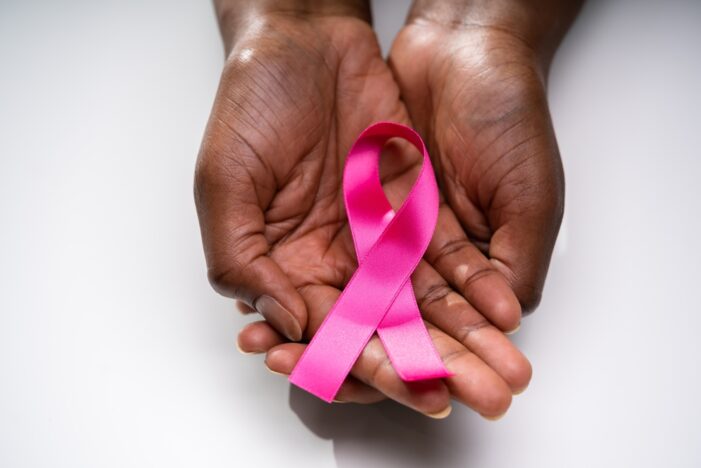By Pearl Phillip
Breast cancer remains one of the most critical public health challenges in the United States. For Black women, however, the burden is uniquely severe—not only in incidence and risk but also in outcomes and mortality rates. Despite medical advances, too many Black women continue to face late diagnoses, aggressive cancer subtypes, and systemic barriers that make survival less likely. Understanding this crisis—and acting to change it—is both a medical and moral imperative.
A Personal Story: Joan’s Fight
For many Black women, breast cancer is not a distant statistic; it is a lived reality. Joan was only 42 when she received her diagnosis—years before most screening guidelines even recommend a first mammogram. A vibrant mother of three, she initially dismissed a persistent lump and tenderness, believing she was “too young” for cancer. When she finally sought medical care, the news was devastating: an aggressive triple-negative breast cancer already at an advanced stage.
Joan’s journey illuminated the many obstacles Black women face—delayed screenings, fragmented specialist care, and a lack of culturally competent support systems. Despite her resilience, Joan passed away three years later. Her story underscores an urgent truth: early detection and equitable care are not just medical priorities—they are matters of justice, family, and survival.
The Stark Reality: Disparities in Incidence and Mortality
While the lifetime risk of developing breast cancer for non-Hispanic Black women is approximately 12%—slightly lower than the 14% for non-Hispanic White women—Black women are 38% more likely to die from the disease. According to the American Cancer Society (2024–2025), this survival gap persists across nearly every cancer subtype.
Several patterns amplify this disparity:
– Earlier onset: Black women are diagnosed at younger ages.
– Aggressive subtypes: Higher incidence of triple-negative and inflammatory breast cancers, which are harder to treat.
– Advanced diagnoses: Greater likelihood of late-stage detection.
Even when diagnosed at similar stages, Black women often face worse outcomes—an unmistakable signal of structural inequity in healthcare access, quality, and responsiveness.
The Science of Inequity: Why Black Women Face Higher Mortality
The causes of disparity are multifaceted—rooted in biology, environment, and systemic bias.
Tumor Biology: Black women have a higher prevalence of aggressive subtypes such as triple-negative breast cancer (TNBC), which lacks hormonal receptors and has fewer treatment options.
Delayed Diagnosis: Due to later screenings or missed follow-ups, cancers are often discovered at more advanced stages.
Barriers to Care: Access to affordable, high-quality screening and treatment remains uneven across racial and socioeconomic lines.
Social Determinants: Health behaviors and outcomes are affected by broader inequities, from neighborhood resources to healthcare mistrust.
Systemic Inequities: Even when access and stage are equal, disparities persist—pointing to deep structural failures in how care is delivered.
A Step Forward: The Black Women’s Health Study Breast Cancer Risk Calculator
For decades, standard risk-prediction models underestimated breast cancer risk in Black women because they were developed primarily from White populations. To address this, researchers introduced the Black Women’s Health Study Breast Cancer Risk Calculator—a tool designed specifically for U.S. Black women.
This model provides a more accurate 5-year and 10-year risk estimate, empowering patients and doctors to make informed decisions about when to start screening, whether to pursue genetic testing, and how to manage prevention strategies. It represents a crucial advancement in equitable medicine: one that recognizes that one size does not fit all.
Early Action, Better Outcomes: What Black Women Can Do Today
Empowerment begins with knowledge and proactive care. Here are key actions every woman should consider:
– Know your body: Perform regular self-exams and note any changes.
– Start screening early: Schedule annual mammograms beginning at age 40, or earlier if high-risk.
– Talk to your doctor: Discuss family history, genetics, and lifestyle factors that may increase risk.
– Seek second opinions: Be persistent—trust your instincts when something feels wrong.
– Prioritize wellness: Maintain healthy weight, limit alcohol, and embrace movement and balanced nutrition.
Breaking Barriers and Building Equity
Addressing breast cancer disparities requires more than awareness; it demands systemic change. Healthcare institutions, policymakers, and community leaders must work together to:
1. Expand access to mammograms and follow-up diagnostics in underserved neighborhoods.
2. Invest in cultural competency training to ensure providers communicate effectively and respectfully with Black women.
3. Include more Black women in clinical research to better understand risk factors and treatment responses.
4. Fund outreach programs that connect survivors with at-risk women to build community trust and awareness.
When Black women receive timely and equitable care—survival outcomes rise dramatically. The data is clear: health equity saves lives.
The Way Forward
The fight against breast cancer among Black women is both a scientific and social-justice issue. The use of tailored risk tools, improved access to screening, and community-based advocacy can narrow the survival gap. But progress depends on sustained action—by doctors, policymakers, families, and women themselves.
Every woman deserves the chance to live, to thrive, and to survive breast cancer with dignity and strength. By empowering Black women with accurate information, equitable resources, and compassionate care, we move closer to a future where breast cancer no longer disproportionately claims Black lives.

